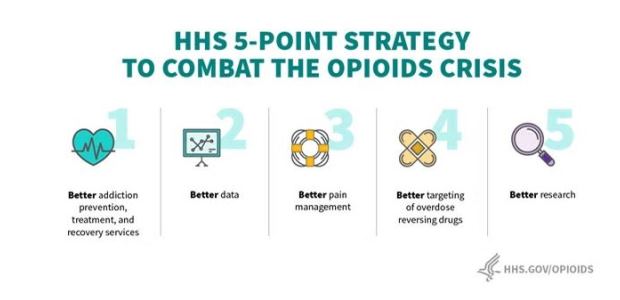
HHS Agencies Award $1 Billion in Opioid Grants
"Addressing the opioid crisis with all the resources possible and the best science we have is a top priority for President Trump and for everyone at HHS," said HHS Secretary Alex Azar. "The more than $1 billion in additional funding that we provided this week will build on progress we have seen in tackling this epidemic through empowering communities and families on the front lines."
Units of the U.S. Department of Health and Human Services awarded more than $1 billion in opioid-specific grants this week to help combat the crisis. The awards support HHS's Five-Point Opioid Strategy, which was launched last year and enhanced this week, according to the agency, which reported that new data suggests efforts are now yielding progress at the national level.
"Addressing the opioid crisis with all the resources possible and the best science we have is a top priority for President Trump and for everyone at HHS," said HHS Secretary Alex Azar. "The more than $1 billion in additional funding that we provided this week will build on progress we have seen in tackling this epidemic through empowering communities and families on the front lines."
"This week, HHS updated its strategic framework for tackling the opioid crisis, which uses science as a foundation for our comprehensive strategy," said Admiral Brett Giroir, assistant secretary for health and senior advisor for opioid policy. "With these new funds, states, tribes, and communities across America will be able to advance our strategy and continue making progress against this crisis."
The 2017 National Survey on Drug Use and Health, conducted by the Substance Abuse and Mental Health Services Administration, found that the number of Americans initiating heroin use dropped by around half from 2016 to 2017. The number of Americans misusing opioids also dropped for the second year in a row, and the number receiving specialty treatment for heroin use increased.
From January 2017 through August 2018, the amount of opioids prescribed in America has dropped by 21 percent, HHS reported. In the same time, the number of prescriptions filled for naloxone increased 264 percent, while the number of prescriptions for buprenorphine, one form of medication-assisted treatment, rose 16 percent (data from IQVIA's Total Patient Tracker). During 2017, opioids claimed more than 130 lives per day in the United States.
The funding announced this week included:
- SAMHSA awarded more than $930 million in State Opioid Response grants to support a comprehensive response to the opioid epidemic and expand access to treatment and recovery support services. The grants aim to increase access to medication-assisted treatment using the three Food and Drug Administration-approved medications for the treatment of opioid use disorder, reducing unmet treatment need, and reducing overdose-related deaths through the provision of prevention, treatment, and recovery activities for opioid use disorder.
- SAMHSA also awarded about $90 million to other programming for states and communities to expand access to medication-assisted treatment, increase distribution and use of overdose reversal drugs, and increase workforce development activities.
- The Health Resources and Services Administration (HRSA) awarded more than $396 million to combat the opioid crisis, with the money enabling HRSA-funded community health centers, academic institutions, and rural organizations to expand access to integrated substance use disorder and mental health services.
- The Centers for Disease Control and Prevention awarded $155.5 million to increase support for states and territories working to prevent opioid-related overdoses, deaths, and other outcomes. In addition, CDC awarded $12 million in funds to support 11 Tribal Epidemiology Centers and 15 tribal entities, and CDC is also distributing an additional $27 million to nine non-governmental organizations tol support states and territories with staffing, procurement, and training to enhance local public health capacity.